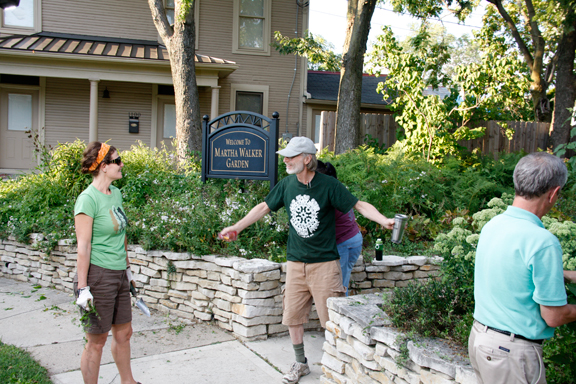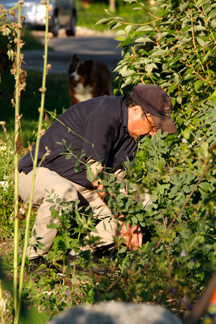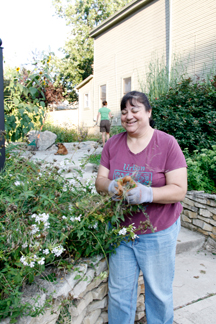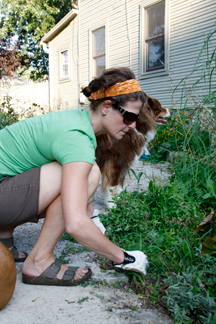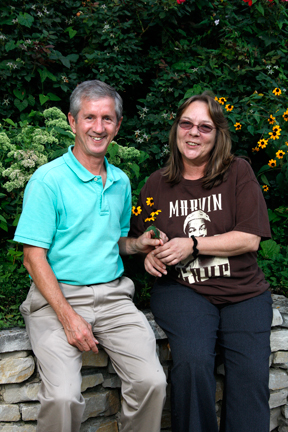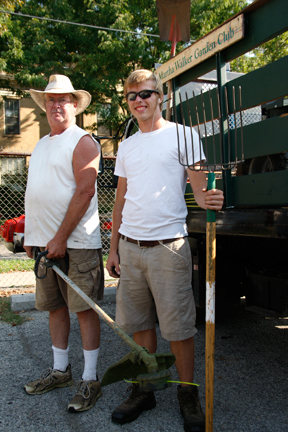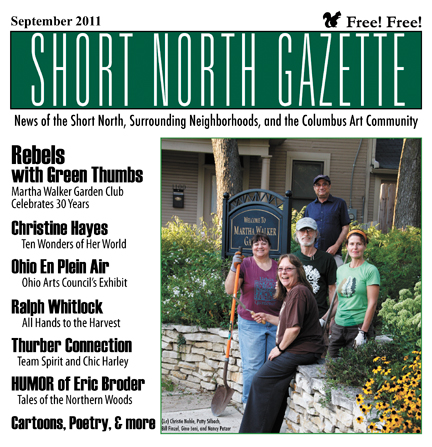
Columbus, Ohio USA
Return to Homepage www.shortnorth.com
Rebels with Green Thumbs
The Martha Walker Garden Club celebrates 30 years of communityi service
By Karen Edwards
September 2011 Issue
Return to Homepage
Return to Features IndexPhotos © Larry Hamill
Garden Club enthusiast Bill Finzel shares a bright idea with board member Nancy Patzer. The Martha Walker Garden Club turns 30 years old this year. You can thank the city of Columbus that the club exists at all.
To understand why, you need to travel back in time to the Short North of the 1980s. Gone are the trendy boutiques, the pocket parks, the lofty new condos and neighborhood homes, landscaped and decorated by the young urban professionals who find Italian Village, Victorian Village and the Short North desirable locations to live and raise a family.
Instead, the Short North – which wasn’t a familiar name in the early ‘80s, points out Ron Diener, the garden club’s founder – was an area of urban blight. Vacant lots existed where today’s storefronts and homes now stand. These lots, overgrown with weeds, had become a dumping ground for unwanted furniture and other debris. “People see trash in a lot and they drop their own there,” says Diener. Consequently, trash blew through the lots, into alleys and across the landscape – attracting rats and insects and creating an area that no one but vagrants wanted to come close to. It was the kind of environment that doesn’t feel like a neighborhood. And if there is one thing that residents of Italian Village – including Diener – wanted, it was a neighborhood they could be proud to live in.
So, says Diener, “We’d call the city and ask them to come clean up the vacant lots. But no one came.”
After all, there was no hue and cry from successful businesses or residents of million-dollar homes screaming at the effrontery of so many weeds and trash-strewn lots. These calls came from civic-minded citizens who wanted a nice neighborhood for their children to play in and for residents to socialize in. It didn’t seem like much to ask.
But still, calls went unanswered.
“It was like we were on the edge of a wilderness,” says Andrew Klein, who became the garden club’s first administrator. In a sense, it was. At the time, Klein recalls, there were blocks of the Italian Village area that had only one residential home on it. “It was a scary area. When I moved into my home in 1987, I would hear gunshots at night.” And the vacant lots? “They were pockmarks on the face of the neighborhood,” Klein says.
That’s a tough area in which to claim some self-respect.
Enter the Martha Walker Garden Club.
Vigilante gardeners
Gino Ieni's love of gardening drew him to the Martha Walker group a few years back. If you’ve been thinking the Martha Walker Garden Club is a little old lady, tea-sipping garden club, you couldn’t be more wrong. And really – what self-respecting little old lady would bring flats of flowers to plant in an area like this?
No, the Martha Walker Garden Club was organized by Diener as a sort of vigilante gardening group. If the city wasn’t going to clean up the lots – they would. And they weren’t about to ask the city for permission.
“One of the club’s first actions was to remove some shrubs and trees the city was planning to remove anyway and plant them in several city-owned sidewalk strips and parks. What revolutionaries we were!” recalls Jim Buckley, one of the club’s founding members.
Landscape designer Christie Nohle has spent 20 years helping the MWGC. Well-known as owner of the former Urban Gardener retail store, her professionalism and generosity have
contributed greatly to the neighborhood.In the dark of night, Diener, Buckley and four or five other men – and some of their wives, Diener adds – would head for a vacant lot, shovels, hoes and trash bags in hand. They’d pick up the trash, thrash the weeds into submission, and plant flowers, shrubs, trees, whatever they had been able to scrounge or re-purpose, and leave behind a more beautiful space.
Night after night, the Martha Walker Garden Club would track down a vacant lot and leave behind a landscaped area that neighbors were proud to walk past. The Martha Walker Club was quickly becoming the Batman of the Short North – swooping into crime-infested areas and leaving behind a safer, more law-abiding-looking community.
But Martha Walker? Why would a group of men, and vigilantes at that, adopt a name like that?“As I remember the story,” says Buckley, “Martha Walker was the first owner of record of much of what is now downtown Columbus, including Italian Village. She was given the parcel by an act of Congress, I think in 1803, as reparation for losses suffered during the American Revolution by her father or husband, Richard Walker.”
During the early 1800s, it was not uncommon for the federal government to award territories to Revolutionary War veterans – and to make reparations to refugees like Martha and Richard Walker, who, as Tories, or royalists during the War, were forced to flee America for Canada (in the case of the Walkers, to Nova Scotia).Diener says he co-opted Martha’s name because “her name was on most of the deeds of city property, though I think she never lived in Ohio.”
Records show Martha Walker sold her land to early speculators (including William Neil, the “stagecoach king”) and as far as early members can recall, none of Martha Walker’s ancestors have ever stepped in to claim the property.
“No, no descendants of Martha Walker ever came forward and identified themselves,” says Diener.
Buckley does recall one individual, however, who claimed to be related to Martha. “This person was offended that we would imply Martha was less than patriotic,” he says.
But records don’t lie. Richard Walker was a Tory and during America’s Revolutionary War, the Tories were backers of England’s King George.
Where Martha stood on the American Revolution is anyone’s guess, but even if she never set foot in Ohio – or favored the patriots – she almost certainly would have applauded what the club was doing to her property. After all, this was a woman who, one way or another, understood Revolution.Gaining strength and civility
Well-behaved pets are welcome at gatherings. Nancy’s two pooches are a familiar sight. By 1983 – and perhaps as a result of the garden club’s guerilla efforts – the city had set up a weed and trash abatement program through its health department. “The program offered to pay community groups to clean up vacant lots and city property within their neighborhoods,” says Klein.
It didn’t take long for the Martha Walker Garden Club to cash in on the program.
By this point, says Buckley, the club had already taken on the responsibility of maintaining a small park on Kerr Street between Hubbard and Hull Alley. And, Diener adds, the group had taken over a vacant lot on Russell Street and was using it as a tree nursery. The city’s new weed abatement program would just be another addition to the group’s growing list of responsibilities. But this one had a benefit. It paid $20 an hour.
So Klein was hired to serve as the club’s administrator – and to hire a two-man crew who could do the work. Soon, the club was bringing in contracts from all over the city.
As the Short North neighborhoods began to look better, the club hosted “Bag-a-Thons” (annual clean-up events) and awards programs to encourage residents to keep up their properties. The “Golden Trowel” award, for example, was presented for years to neighborhoods that had made outstanding improvements in their areas. “We used awards as incentives,” says Klein.Bush hogs and weed snitches
But after six years of managing the Martha Walker Garden Club, Klein decided it was time to move on. The group’s next administrator was Maria Galloway, owner of pm gallery, who served for one year. She looks back at that year as a time she stretched right out of her comfort zone. “I had to learn what a bush hog was,” she recalls. “It’s a gigantic mower we’d move all over the city to mow lawns.”
That Galloway found herself administrator of the garden club shouldn’t come as much of a surprise to those who know her. After all, for years, Galloway and her husband Michael acted as garden club “spies.” “We were weed snitches,” Galloway says. “We’d ride our bikes around the neighborhood, and report properties that had a lot of weeds.”
As administrator, however, Galloway found herself (along with crew head Greg Maynard) managing bush hogs and residents who’d complain their grass wasn’t cut.
“The year I served as administrator, we had a very rainy spring,” Galloway says. “Residents would call and say ‘you didn’t cut our grass.’ We did, but they didn’t realize how fast grass can grow in a rainy spring.”
Galloway also remembers that one of the club’s crew, Dan Goodyear, handled some of the club’s private contracts at night because of his schedule. “He’s this big gentle-giant kind of guy, but one night, he went to weed around a sorority house on the OSU campus,” she says. There he was, in the dark, skulking in the weeds under the windows. The girls had no idea who he was or why he was there. “He scared the girls to death,” Galloway recalls with a laugh.From red to black
Tim Wagner, administrator since 1994, stepped down this year. Gardening veteran Patty Silbach was hired to fill his shoes. Despite the increasing number of private contracts and the funds from the city’s weed abatement program, however, everything wasn’t completely rosy at the garden club. Its books were bleeding red ink.
Enter Tim Wagner, director of the Short North Special Improvement District. He learned from a friend that the club needed an administrator – someone who could move the club back into the black, so he accepted the challenge.
“I heard the group needed a lot of help,” Wagner says. Part of the problem, he discovered, was that the paid, two-man crew was spending time doing what was essentially volunteer work. “We organized it so they would spend their time only on paid projects.” Volunteers were recruited to handle the non-paid work.
But even with the removal of non-paid work, the club’s two-man crew was kept busy. The city’s weed abatement program was only one part of the club’s workload, Wagner explains. “We also had a contract with the city to mow street medians and parks in the Short North and Linden areas. It was city property, but the city found it less expensive to hire us than to assign city workers to the job.” Piled on top of the city jobs, of course, were all the private contracts with area residents to mow and even landscape properties.
Wagner recalls stories told by the crew when they returned from their jobs – of homeless encampments hidden by tall weeds that the crew had been sent to cut down, of squatters inside vacant homes, and various animal skeletons discovered amid the weeds.
Eventually, work from the weed abatement program began to diminish in the Short North as vacant lots became developed and vacant homes were purchased and maintained by new owners. “After a while, we didn’t have any work in the Short North, just Linden and Franklinton,” says Wagner.
But thanks to Wagner’s organizational abilities, the club had turned a corner. Once again the Martha Walker Garden Club was operating in the black, and was actually making enough money that the board felt comfortable assisting other civic groups with their beautification efforts. “We limited our (financial) help to the Short North at first, but eventually expanded it to the city’s boundaries as of 1959,” says Wagner. Over the years, the Martha Walker Garden Club has awarded grants to Friends of Iuka Ravine, Friends of Goodale Park, the Italian Village Park and others.
It seems a far cry from those early beginnings of guerilla gardening when the group would sell plants to raise funds. “We found iris on one vacant lot,” Diener recalls. “We dug them up and re-planted them in that strip between the sidewalk and the street.” When spring came, members returned to the site, retrieved the iris and sold them, in addition to other plants, in area neighborhoods and at Comfest. Today, the club still mans a booth at Comfest – but it’s for self-promotion, not fundraising, says Wagner.Revolutionary tactics and tricks
But just because the Martha Walker Garden Club has moved away from its guerilla-gardening beginnings doesn’t mean its revolutionary mindset is forgotten.
“I remember hearing of one occasion when early organizers were concerned about cars speeding down a neighborhood street,” says Klein. The club petitioned the city for a stop sign at the location, but, as with the vacant lot clean-up, their requests went unanswered. Once again, club members took the situation into their own hands. “They moved a stop sign from another location which wasn’t as dangerous as the location where cars were speeding through,” Klein says. Apparently there were no repercussions from the city. “I’m not sure they even know about it,” says Klein.
Garden club members have also been blessed with a wicked sense of humor. Klein says when he first moved into the area, he accepted an invitation to the garden club’s board meeting. There, Diener persuaded Klein to run for club secretary. After all, Diener told Klein, he was running for the post as well, and didn’t want to run as a lone candidate. So Klein agreed – only to find shortly after the meeting that Diener had placed an ad in the neighborhood newspaper declaring his support for Klein as club secretary. “I won the election,” Klein says. “That’s how I became involved in the club.”How the club works
MWGC crew chief Terry Williams (left) and Rex Gray put in full-time work citywide, including one day a week maintaining properties owned by the Wood Companies in the Short North. The Martha Walker Garden Club actually consists of five or six board members who meet monthly to discuss projects, finances and other business. “The rest are volunteers,” says Klein, who has become a volunteer himself since leaving his administrative job.
?A 3/4-ton stake-bed truck owned by the Martha Walker Garden Club makes all this possible. And over the years, there have been plenty of Martha volunteers and supporters. Christie Nohle, a landscape designer and owner of the former Urban Gardener, for example, has volunteered for the club for two decades and has served as a board member for 13 years. Greg Maynard has volunteered for club projects after leaving his paid crew member post, and former crew chief David Houston is now one of the club’s board members. Then, there are the Berry brothers, Kevin and Dick, who not only gave the club a ¾-ton stake-bed truck to use when it was first receiving contracts, but a garage to store it in and regular truck maintenance and repair. “Without them,” says Klein, “We couldn’t have accepted all the contracts we did.” Six years ago, after two other used trucks, the club purchased its own brand-new truck. “We had the money,” says Wagner, “and we thought we’d buy it new rather than continuing to spend money on repairs and maintenance.”
Then there are all the administrators who have kept the club running. In addition to Klein, Galloway and Wagner, these have included Becky Michaelfelder, minister at Third Avenue Community Church, and now Patty Silbach, an avid gardener and Italian Village resident.
Today, Martha Walker Garden Club volunteers maintain the walk-through park between Mt. Pleasant and Say avenues just south of East Fourth Avenue. “Weed and Feed” events – designated days and times when volunteers push up their sleeves and plant, weed and perform maintenance chores – are held seasonally. For their efforts, the club provides them with a meal – hence, “Weed and Feed.”
The volunteer events, the private and city contracts continue a beautification and improvement mission now 30 years old.
When he moved out of state at the end of the ‘80s, Buckley says, “I thought the club was alive and well – and far more legitimate by the time we left.”
But did any of the club’s founding members think the club would exist 30 years later?
“I never thought the club would last that long,” says Diener.
After all, the group began with a single purpose, a revolutionary remedy to an urban problem. That it continues today, 30 years after Diener rustled up some like-minded rebels, is a testament to the very thing that Diener and his group sought to create: A neighborhood that anyone would be proud to live in.Visit the Martha Walker Garden Club Facebook page or email npatzer@columbus.rr.com for more information.
© 2011 Short North Gazette, Columbus, Ohio. All rights reserved.
Return to Homepage www.shortnorth.com
